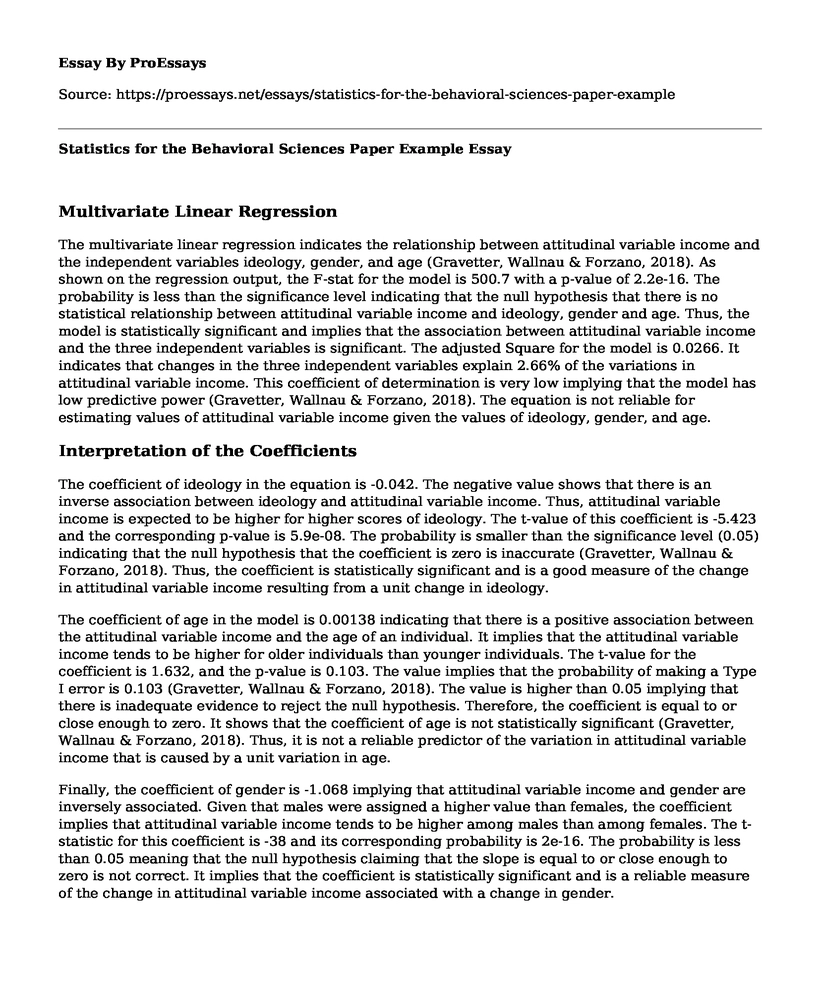Multivariate Linear Regression
The multivariate linear regression indicates the relationship between attitudinal variable income and the independent variables ideology, gender, and age (Gravetter, Wallnau & Forzano, 2018). As shown on the regression output, the F-stat for the model is 500.7 with a p-value of 2.2e-16. The probability is less than the significance level indicating that the null hypothesis that there is no statistical relationship between attitudinal variable income and ideology, gender and age. Thus, the model is statistically significant and implies that the association between attitudinal variable income and the three independent variables is significant. The adjusted Square for the model is 0.0266. It indicates that changes in the three independent variables explain 2.66% of the variations in attitudinal variable income. This coefficient of determination is very low implying that the model has low predictive power (Gravetter, Wallnau & Forzano, 2018). The equation is not reliable for estimating values of attitudinal variable income given the values of ideology, gender, and age.
Interpretation of the Coefficients
The coefficient of ideology in the equation is -0.042. The negative value shows that there is an inverse association between ideology and attitudinal variable income. Thus, attitudinal variable income is expected to be higher for higher scores of ideology. The t-value of this coefficient is -5.423 and the corresponding p-value is 5.9e-08. The probability is smaller than the significance level (0.05) indicating that the null hypothesis that the coefficient is zero is inaccurate (Gravetter, Wallnau & Forzano, 2018). Thus, the coefficient is statistically significant and is a good measure of the change in attitudinal variable income resulting from a unit change in ideology.
The coefficient of age in the model is 0.00138 indicating that there is a positive association between the attitudinal variable income and the age of an individual. It implies that the attitudinal variable income tends to be higher for older individuals than younger individuals. The t-value for the coefficient is 1.632, and the p-value is 0.103. The value implies that the probability of making a Type I error is 0.103 (Gravetter, Wallnau & Forzano, 2018). The value is higher than 0.05 implying that there is inadequate evidence to reject the null hypothesis. Therefore, the coefficient is equal to or close enough to zero. It shows that the coefficient of age is not statistically significant (Gravetter, Wallnau & Forzano, 2018). Thus, it is not a reliable predictor of the variation in attitudinal variable income that is caused by a unit variation in age.
Finally, the coefficient of gender is -1.068 implying that attitudinal variable income and gender are inversely associated. Given that males were assigned a higher value than females, the coefficient implies that attitudinal variable income tends to be higher among males than among females. The t-statistic for this coefficient is -38 and its corresponding probability is 2e-16. The probability is less than 0.05 meaning that the null hypothesis claiming that the slope is equal to or close enough to zero is not correct. It implies that the coefficient is statistically significant and is a reliable measure of the change in attitudinal variable income associated with a change in gender.
Conclusion
The above analysis shows that the model showing the association between attitudinal variable income and the three independent variables is statistically significant. The coefficients expect that of age is statistically significant. The coefficient of determination is only 2.6% implying that the predictive power of the model is very low. Thus, the independent variable affects attitudinal variable income. However, the model is not reliable in estimating attitudinal variable income. Other independent variables such as level of education, among other socio-demographic variables, should be added to the model to improve its coefficient of determination or predictive power.
Reference
Gravetter, F., Wallnau, L., & Forzano, L. (2018). Essentials of statistics for the behavioral sciences. Boston, MA: Cengage Learning.
Cite this page
Statistics for the Behavioral Sciences Paper Example. (2022, Sep 26). Retrieved from https://proessays.net/essays/statistics-for-the-behavioral-sciences-paper-example
If you are the original author of this essay and no longer wish to have it published on the ProEssays website, please click below to request its removal:
- Personal and Cultural Infant Sleeping and Feeding Trends
- Essay Sample on Communication Issue in a Workplace
- Aging Black in America Essay Example
- The Impact of the Office Environment - Essay Sample
- Civility: The Key to a Fully-Functioning Society - Research Paper
- Navigating Leadership Challenges: Women's Representation and Emotional Intelligence at Tizer Pharmaceutical Firm
- Report Sample on Mass Communication on Marginalized Groups







